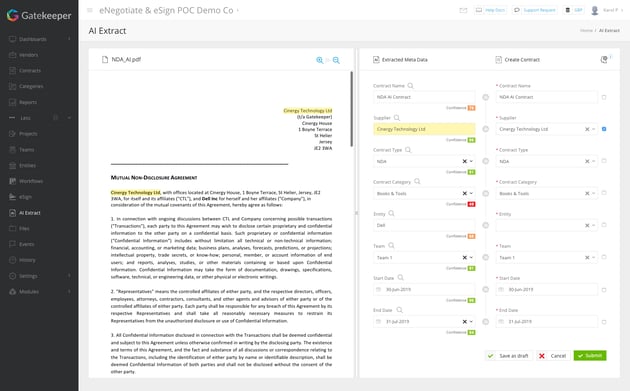At Gatekeeper, we have many conversations with prospective customers where they reveal that implementing a contract management system in their business has been on their agenda for a significant period of time.
However, what we often see in these cases are small internal teams responsible for managing large volumes of contracts.
Not only does this lead to busy day-to-day workloads for these teams, but also very little time to address legacy contracts in a meaningful way.
The legacy contract migration process that comes with implementing a new Vendor and Contract Lifecycle Management system may feel overwhelming for already burdened teams.
In this article, we help you to break down the steps of legacy contract migration, so you can manage your historical agreements without increasing your workload exponentially.
why are Legacy contracts difficult to manage?
Legacy contract issues are caused by a large volume of historic agreements which may not be stored in an accessible or organised way.
Businesses often experience difficulties handling historical agreements when:
- Contracts are spread across different departments and storage systems
- Newer agreements are prioritised for systematic management
- Acquisitions increase the volume of legacy contracts requiring attention.
Searching through filing cabinets, scanning documents and gaining access to old email accounts isn’t very enticing. But neither is the prospect of poor contract visibility, a lack of control and the potential for non-compliance.
The longer it is left undone, the larger that initial task gets as more contracts are signed in the meantime.
With the right contract migration strategy and the use of technology, this task can be broken down into far more manageable chunks.
A step-by-Step Legacy Contract Migration strategy
When it comes to organising your historic contract data, the two main areas that you need to focus on initially are:
- Finding all your contract documents and building them into a central contract repository
- Organising your contracts within the repository through the strategic use of contract metadata
Watch this video to find out more about Gatekeeper's contract repository
1. Centralise your contracts and documents
A central feature of VCLM software is the contract repository. It should be your business’s single source of truth for its agreements.
A robust contract repository holds all the current contracts for every business relationship, as well as the historical versions and a clear timeline to show when these later versions came into effect.
To build your contract repository, you need to understand the scope of your business and where its current agreements are.
The key steps to be followed are:
- Conduct a comprehensive audit: Start by conducting a thorough audit of all your existing systems, departments, and storage locations. This will help you identify areas where contract documents might be stored. Include physical file cabinets, shared drives, email attachments, and any other relevant sources.
- Follow the money. Speak to your Finance Team and ask to review records of monthly, quarterly and annual payments that are leaving your company’s accounts. This will give you a good indication of live business arrangements for which there should be paperwork stored somewhere.
- Engage with key stakeholders. Once you’ve compared the existing records with what’s being paid for via the Finance Department, you need to collaborate with different departments and individuals within your organisation to ensure that you don't overlook any potential contract sources. This includes Legal, Procurement and Contract Owners.
- Digitise paper agreements. You will likely have a variety of formats to deal with from electronically signed documents through to hard copies. It’s vitally important to have digital versions of every agreement so make sure you use a scanner with OCR enabled to create these and be able to search through them if required.
Remember, your first pass at this is highly unlikely to yield a 100% success rate. However, you should be aiming to cover off 80% of your business’s spend in the first instance. Following the Pareto Principle, this will likely mean that you’ll need to find the top 20% of contracts by value.
2. Organise your legacy contracts with metadata
Contract metadata is the structured information about a contract.
It enables you to:
- Segment and search your contracts by your chosen data-points
- Report on contract performance
- Highlight key dates and ensure renewals and other milestones are hit
- Maintain compliance across your contracts and vendors
To maintain order within your contract repository and make legacy contract migration seamless, it's important to define your contract metadata fields and conventions.
Define relevant metadata fields
Begin by identifying the metadata fields that are most relevant to your organisation's contract management needs. Common metadata fields include contract title, counterparty name, contract type, effective date, expiration date, contract owner, and contract status.
Implement a consistent naming convention
Establish a consistent naming convention for your contracts that reflects the content and purpose of the agreement. This will make it easier to search for specific contracts and improve overall organisation within the repository. Consider including relevant information such as contract type, counterparty name, and effective date in the contract title.
Automate your Legacy Contract Migration with VCLM Software
If your business has large volumes of legacy contracts, the amount of time and effort required for a successful migration will feel offputting.
The good news is that Gatekeeper has developed an artificial intelligence solution called AI Extract™, which is designed to reduce the manual effort of dealing with legacy contracts to minimal levels.
AI Extract™ automatically extracts key metadata from uploaded contracts - in a scanned or PDF format - and populates data fields with information. Individual data points are presented with confidence scores and users can accept or amend as appropriate.
By confirming or amending the results the system is further taught as to what works and will provide a superior service the next time.

At Gatekeeper, we’ve got a huge amount of experience helping our customers move their historic contracts onto our platform. Our Professional Services team supports all new customers through their initial period and provides guidance on how to structure the data and the most efficient process for getting it uploaded.
Using a combination of AI Extract™ and tailored bulk-upload sheets, your contract information can be pushed directly into Gatekeeper and your contract repository can be created.
If you're looking to migrate your legacy contracts with minimal overhead on your resources, you can use Gatekeeper's AI Extract™ Managed Service for assistance with end-to-end processing of high-volume legacy data with minimal overhead on your resources.
The benefits of legacy contract migration
If you follow the steps above to migrate your historical agreements, you’ll have a well-structured central repository of your business contracts.
This will give you new insight into your business arrangements, enabling you to:
- Identify areas for cost consolidation and reduction
- Prepare in timely fashion for renewals and contract negotiations
- See at a glance whether your contract partners are compliant
- Reduce business risk
- Cut down the time spent on contract administration
If you’re looking to implement a vendor and contract management solution and have a significant volume of legacy contracts to work with, then get in touch with us today to find out how we can help.

.png)
.png)
.png)
-4.png)